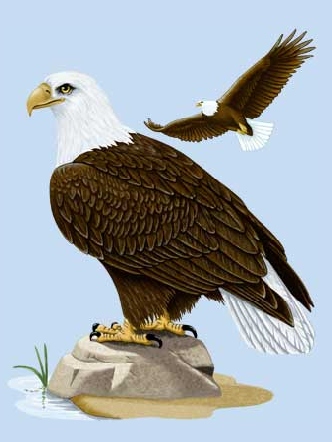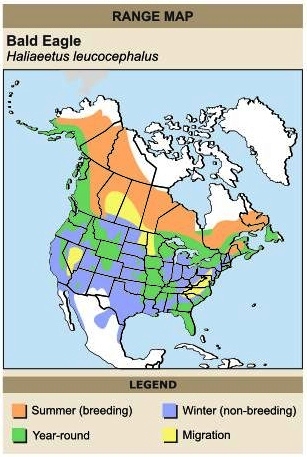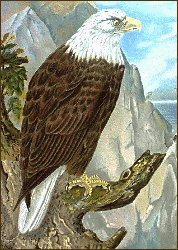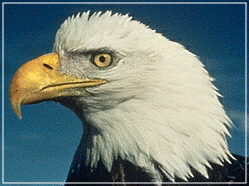|

Large, hawk-like
bird, dark brown body and white head, tail. Heavy bill, legs, feet, eyes
are yellow. Hunts for fish, which it sometimes steals from ospreys. Eats
carrion and crippled or injured squirrels, rabbits, muskrats and waterfowl.
Flap-and-glide flight, also soars on thermals.

|
BALD
EAGLE
Haliaeetus leucocephalus
FALCONIFORMES
Kites, Eagles and Hawks (Accipitridae)
Range and Habitat
Formerly distributed across most of North America; now limited to breeding
in Alaska, Canada, northern Great Lakes states, Gulf coast states, and
the Pacific northwest. Move south from northern breeding grounds during
winters. Preferred habitats include open water areas that support large
numbers of waterfowl or fish.

SOUND: "kleek-kik-ik-ik", "kak-kak-kak"
The Bald Eagle has been the symbol of the United States of America since
1782. At one time, the word “bald” (balde) meant white—not
hairless—referring to the white head and upper neck of the adult
Bald Eagle. They can live up to 40 years in the wild and even longer
in captivity.
A group of eagles has many collective nouns, including an "aerie",
"convocation", "jubilee", "soar", and
"tower" of eagles.
The Bald Eagle is native to Mexico, Canada and the United States. It
is also native to Saint Pierre and Miquelon. It has been seen in the
US Virgin Islands as well as Puerto Rico, Bermuda, Ireland and Belize.
The range of this bird is thought to be around 9 million kilometers.
The Bald Eagle's population in the United States declined through the
1960s as a result of habitat destruction and hunting. During the past
three decades, the population has seen significant increase and the
Bald Eagle now has a rating of Least Concern.

|